古琴介绍中英文
- 格式:docx
- 大小:1.26 MB
- 文档页数:4
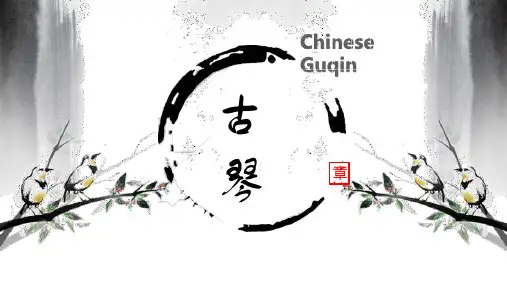
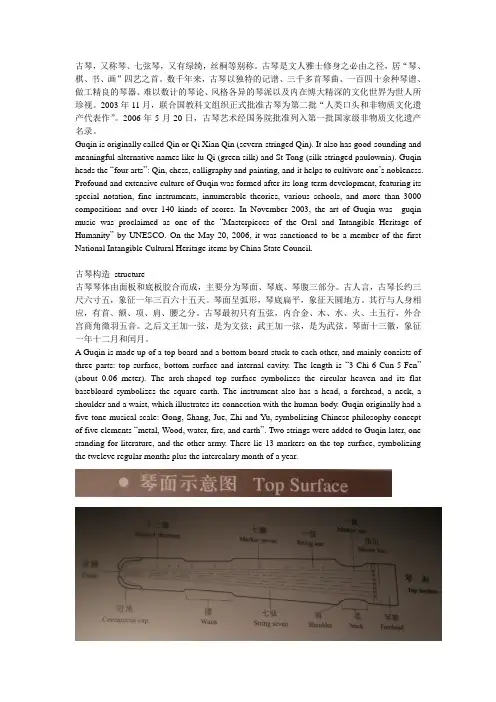
古琴,又称琴、七弦琴,又有绿绮,丝桐等别称。
古琴是文人雅士修身之必由之径,居“琴、棋、书、画”四艺之首。
数千年来,古琴以独特的记谱、三千多首琴曲、一百四十余种琴谱、做工精良的琴器、难以数计的琴论、风格各异的琴派以及内在博大精深的文化世界为世人所珍视。
2003年11月,联合国教科文组织正式批准古琴为第二批“人类口头和非物质文化遗产代表作”。
2006年5月20日,古琴艺术经国务院批准列入第一批国家级非物质文化遗产名录。
Guqin is originally called Qin or Qi Xian Qin (severn-stringed Qin). It also has good-sounding and meaningful alternative names like lu Qi (green silk) and St Tong (silk-stringed paulownia). Guqin heads the “four arts”: Qin, chess, calligraphy and painting, and it helps to cultivate one’s nobleness. Profound and extensive culture of Guqin was formed after its long-term development, featuring its special notation, fine instruments, innumerable theories, various schools, and more than 3000 compositions and over 140 kinds of scores. In November 2003, the art of Guqin was guqin music was proclaimed as one of the “Masterpieces of the Oral and Intangible Heritage of Humanity”by UNESCO. On the May 20, 2006, it was sanctioned to be a member of the first National Intangible Cultural Heritage items by China State Council.古琴构造structure古琴琴体由面板和底板胶合而成,主要分为琴面、琴底、琴腹三部分。
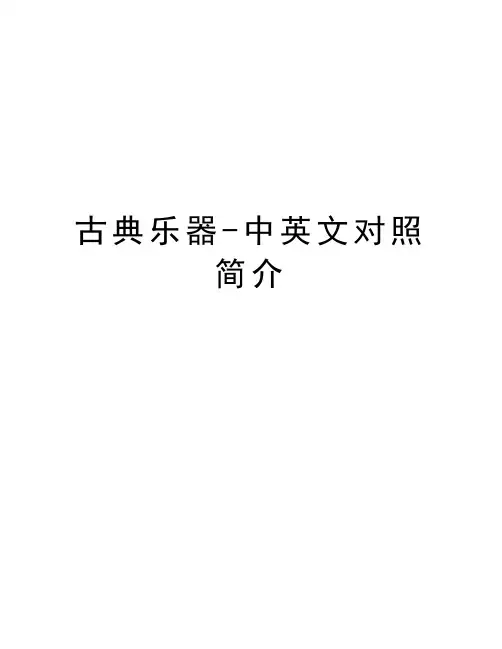
古典乐器-中英文对照简介古琴:Qin, also known as Yao Qin, Yu-Qin, a lyre, for the Chinese one of the oldest plucked instruments, the qin is already prevalent in the Confucian period instruments, there are words to consider the history of thousand years, according to "Historical Records" contains, The emergence of Qin period no later than Yao and Shun. The beginning of this century, only for the distinction of Western instruments in the "piano" added in frontof a word "historic", called "Qin." Still ringing in his study so far, the ancient musical instruments on stage.巴乌Bau, is a bamboo reed instruments copper, spring for the tongue. The Yi, Hani, Dai, Wa, Blang, Miao and other ethnic wind instruments. Yi called the local "and Fei Limo", Hani called "Meiba." Bau is popular in southwest China Yi, Miao, Hani and other single-reed wind instrument family, Bau is made with bamboo, has eight finger holes (seven before the latter), disposed in the mouthpiece of a brass reed tongue tip, blowing across the top of playing, vibrating reed sound. Bau smaller volume, but the sound soft, southwest China's people call it a talking instrument. Bau popular int he Red River in Yunnan Province, Wenshan, Simao, Xishuangbanna, Lincang, Dehong, meltwater Guangxi Zhuang Autonomous Region, Guizhou Province, Guizhou and South Guizhou and other places.Dizi (笛子): The dizi is a bamboo flute.It has been suggested thatthe instrument originated in Southern orCentral Asia over 2000 yearsago. It is a unique solo instrument and isalso used extensively inensembles and orchestras. These flutes have 6open holes and a lovelybright sound.笛子是由竹子做成的乐器,据说在2000年前最早出现于南亚和中亚。
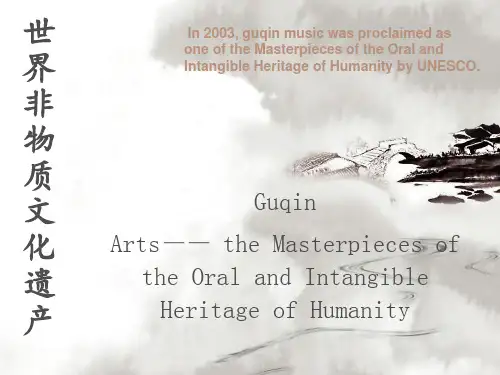
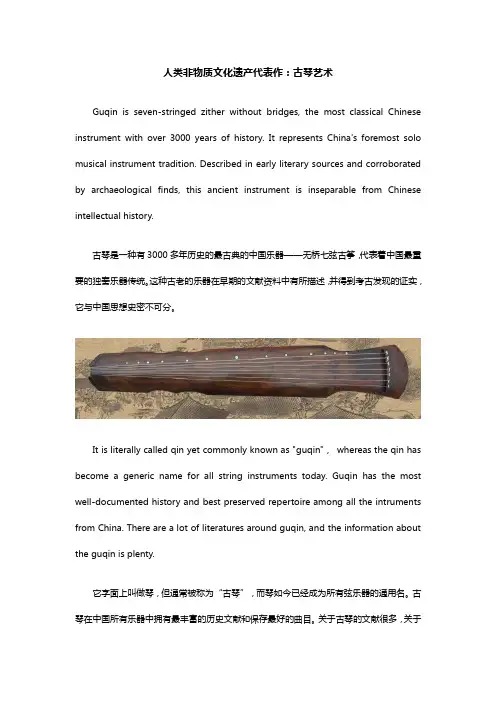
人类非物质文化遗产代表作:古琴艺术Guqin is seven-stringed zither without bridges, the most classical Chinese instrument with over 3000 years of history. It represents China's foremost solo musical instrument tradition. Described in early literary sources and corroborated by archaeological finds, this ancient instrument is inseparable from Chinese intellectual history.古琴是一种有3000多年历史的最古典的中国乐器——无桥七弦古筝,代表着中国最重要的独奏乐器传统。
这种古老的乐器在早期的文献资料中有所描述,并得到考古发现的证实,它与中国思想史密不可分。
It is literally called qin yet commonly known as "guqin",whereas the qin has become a generic name for all string instruments today. Guqin has the most well-documented history and best preserved repertoire among all the intruments from China. There are a lot of literatures around guqin, and the information about the guqin is plenty.它字面上叫做琴,但通常被称为“古琴”,而琴如今已经成为所有弦乐器的通用名。

古琴介绍英文作文The guqin, also known as the Chinese zither, is a traditional Chinese musical instrument with a history spanning thousands of years. Renowned for its elegant and serene sound, the guqin holds a significant place in Chinese culture and music. Let's delve into an introduction to this captivating instrument.Historical Background:The origins of the guqin can be traced back to ancient China, with evidence of its existence dating as far back as 3,000 years ago. Initially, the instrument was primarily associated with the scholarly class, revered for itsability to evoke deep emotions and contemplation. Throughout history, the guqin has been intertwined with poetry, philosophy, and traditional Chinese arts, embodying the essence of Chinese civilization.Physical Characteristics:The guqin features a long, rectangular wooden body, typically made from precious woods such as rosewood or Chinese catalpa. It has seven strings, traditionallycrafted from silk but nowadays often replaced with nylon or metal, stretched across a series of bridges. These strings are tuned to specific pitches, allowing for a wide range of tones and melodies. The instrument is played using a set of finger picks, known as "pian," which are worn on the fingertips of the right hand.Playing Technique:Playing the guqin requires a delicate touch and precise finger movements. Each finger pick corresponds to aspecific string, and the player plucks the strings with varying degrees of force to produce different tones. Unlike some other string instruments, such as the guitar, the guqin does not use frets, making it necessary for the player to rely on muscle memory and intuition to find the correct notes. Mastery of the instrument demands years of dedicated practice and study.Symbolism and Cultural Significance:In Chinese culture, the guqin holds profound symbolic meaning, representing refinement, introspection, and the pursuit of harmony. Historically, it was regarded as a tool for self-cultivation and moral development, with scholars often turning to its music for inspiration and solace. The guqin's association with ancient philosophical and literary traditions, such as Confucianism and Daoism, further enhances its cultural significance.Music and Repertoire:The music of the guqin is characterized by its ethereal and meditative qualities, evoking images of misty mountains, tranquil rivers, and the timeless beauty of nature. Traditional guqin music encompasses a vast repertoire of melodies, many of which have been passed down through oral tradition for centuries. These pieces often bear evocative titles and are deeply rooted in Chinese history and mythology, serving as a means of preserving culturalheritage.Modern Revival and Global Influence:In recent years, there has been a resurgence ofinterest in the guqin both within China and internationally. Efforts to preserve and promote traditional Chinese music have led to increased awareness and appreciation of the instrument's unique charms. Today, enthusiasts from around the world seek to learn the art of guqin playing, drawn to its rich history, spiritual depth, and timeless beauty.In conclusion, the guqin stands as a testament to the enduring legacy of Chinese culture and civilization. Withits graceful melodies and profound symbolism, it continuesto captivate audiences and inspire musicians worldwide. As we journey through the melodies of the guqin, we are reminded of the timeless wisdom and beauty that transcends borders and generations.。

古琴介绍英文作文The guqin, also known as the Chinese zither, is a traditional Chinese musical instrument that has a historyof over 3,000 years. It has a long, narrow wooden body and seven strings, and is often associated with scholars, poets, and artists in Chinese culture.In traditional Chinese culture, the guqin is often seen as a symbol of refinement and elegance. It is often used in scholarly pursuits and is considered a tool for self-cultivation and introspection. Its soft, soothing tones are said to have the ability to calm the mind and elevate the spirit.The guqin is played using a variety of playing techniques, including plucking, strumming, and harmonics.Its music is often characterized by its subtle and nuanced expression, with a focus on creating a sense of tranquility and contemplation.The guqin has a rich repertoire of music, including solo pieces, ensemble music, and improvisational pieces.Its music often draws inspiration from nature, ancient poetry, and philosophical concepts, and is known for its deep emotional resonance and spiritual depth.In recent years, the guqin has experienced a resurgence in popularity, both in China and around the world. It has been recognized by UNESCO as a Masterpiece of the Oral and Intangible Heritage of Humanity, and has gained a dedicated following of enthusiasts and practitioners who are passionate about preserving and promoting this ancient musical tradition.。
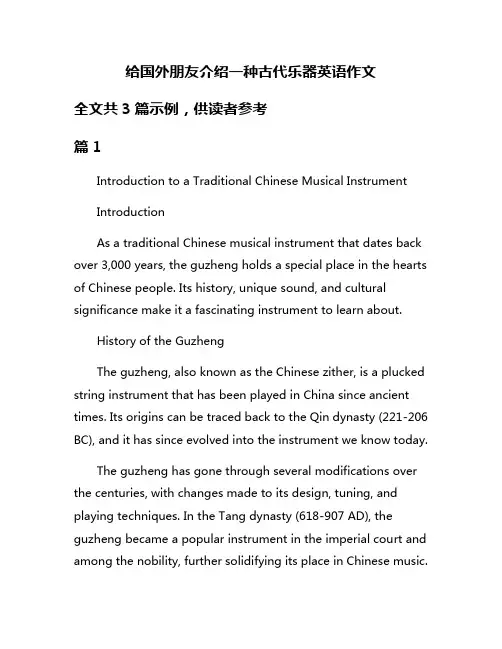
给国外朋友介绍一种古代乐器英语作文全文共3篇示例,供读者参考篇1Introduction to a Traditional Chinese Musical InstrumentIntroductionAs a traditional Chinese musical instrument that dates back over 3,000 years, the guzheng holds a special place in the hearts of Chinese people. Its history, unique sound, and cultural significance make it a fascinating instrument to learn about.History of the GuzhengThe guzheng, also known as the Chinese zither, is a plucked string instrument that has been played in China since ancient times. Its origins can be traced back to the Qin dynasty (221-206 BC), and it has since evolved into the instrument we know today.The guzheng has gone through several modifications over the centuries, with changes made to its design, tuning, and playing techniques. In the Tang dynasty (618-907 AD), the guzheng became a popular instrument in the imperial court and among the nobility, further solidifying its place in Chinese music.Design and ConstructionThe guzheng is a 21-stringed instrument with a flat soundboard made of paulownia wood. The strings are made of silk or metal and are stretched over movable bridges, allowing players to adjust the tuning as needed. The instrument is played using the right hand to pluck the strings and the left hand to press down on the strings to change pitch.The guzheng's shape is long and rectangular, with Chinese symbols or intricate designs often painted on the soundboard. The instrument is typically played on a low table, with the player sitting on a stool to maintain the correct posture.Sound and Playing TechniquesThe guzheng produces a rich, resonant sound that is both soothing and expressive. The instrument's wide range of tones allows players to create a variety of melodies and harmonies, making it a versatile instrument for solo performances or ensemble playing.Playing the guzheng requires a high level of skill and precision, as players must use both hands independently to pluck the strings and create intricate patterns of notes.Techniques such as bending, vibrato, and glissando are commonly used to add depth and emotion to the music.Cultural SignificanceIn Chinese culture, the guzheng is often associated with elegance, grace, and refinement. It is frequently used in traditional Chinese music, dance, and theater performances, adding a touch of authenticity and tradition to the art form.The guzheng has also gained popularity beyond China's borders, with musicians around the world incorporating the instrument into their music. Its distinctive sound and unique playing techniques make it a valuable addition to any musical ensemble.ConclusionThe guzheng is a timeless instrument that continues to captivate audiences with its beauty and complexity. Its long history, unique design, and cultural significance make it a truly special instrument that deserves to be celebrated and cherished for generations to come. Whether you are a music lover or simply curious about Chinese culture, the guzheng is definitely worth exploring and experiencing for yourself.篇2Introduction to a Traditional Musical Instrument in China: GuzhengAs a symbol of Chinese culture and tradition, the guzheng is a beautiful and melodious musical instrument that has been played for centuries. Its history can be traced back to over 2,500 years ago and it has become one of the most popular traditional instruments in China. In this article, we will introduce the guzheng to our foreign friends and explore its unique features and importance in Chinese music.Origin and HistoryThe guzheng, also known as the Chinese zither, is a plucked string instrument that has a history dating back to ancient times. It is believed that the guzheng was first created during the Warring States period in China (475 - 221 BC) and has evolved over the centuries to become the instrument we know today. The guzheng is typically made of wood and has 21 strings, which are plucked with the fingers to produce beautiful sounds.Features and Playing TechniqueOne of the most distinctive features of the guzheng is its large, flat soundboard, which is covered with strings that are stretched across the instrument. The strings are made of eithermetal or silk and are tuned to different pitches to create a wide range of tones. To play the guzheng, the musician uses their right hand to pluck the strings while their left hand presses down on the strings to change the pitch. The technique of playing the guzheng requires precision and skill, as the musician must use their fingers to create intricate melodies and harmonies.Importance in Chinese MusicThe guzheng holds a special place in Chinese music and culture, as it is often used to perform traditional Chinese music and folk songs. It is also commonly featured in Chinese opera and instrumental ensembles, where its beautiful and haunting melodies add a unique depth to the performance. The guzheng is known for its versatility and can be played in a variety of styles, from delicate and soothing to powerful and expressive.ConclusionIn conclusion, the guzheng is a traditional Chinese musical instrument that has captivated audiences for centuries with its beauty and elegance. Its rich history and unique features make it a symbol of Chinese culture and tradition, and it continues to be a beloved instrument in modern times. For those interested in learning more about Chinese music and culture, the guzheng is a wonderful instrument to explore and experience.篇3Introduction of GuqinThe Guqin, also known as the Chinese zither, is a traditional Chinese musical instrument that has a history dating back thousands of years. It is considered one of the oldest stringed instruments in the world and holds a special place in Chinese culture and history.The Guqin is a seven-stringed instrument that is played using the fingertips or fingernails. It is made from a special type of wood and has a long, narrow body with a sound box at one end. The strings are made from silk and are tuned using tuning pegs at the top of the instrument.The Guqin is often referred to as the instrument of the sages, as it has been associated with scholars, poets, and philosophers throughout Chinese history. It is said to have a deep and expressive sound that can evoke a range of emotions in the listener.Playing the Guqin is a complex and highly skilled art form that requires years of practice and dedication. Players must learn a wide range of techniques, including plucking, sliding, and harmonics. The music produced by the Guqin is often describedas hauntingly beautiful and can transport listeners to another time and place.In addition to its musical significance, the Guqin also holds a special place in Chinese art and literature. It is often depicted in paintings and poems, and is considered a symbol of Chinese traditional culture and values.Overall, the Guqin is a unique and fascinating instrument that has been passed down through generations in China. Its rich history and cultural significance make it a valuable and treasured part of Chinese heritage. I hope that this introduction has given you a better understanding of this ancient and beautiful instrument.。
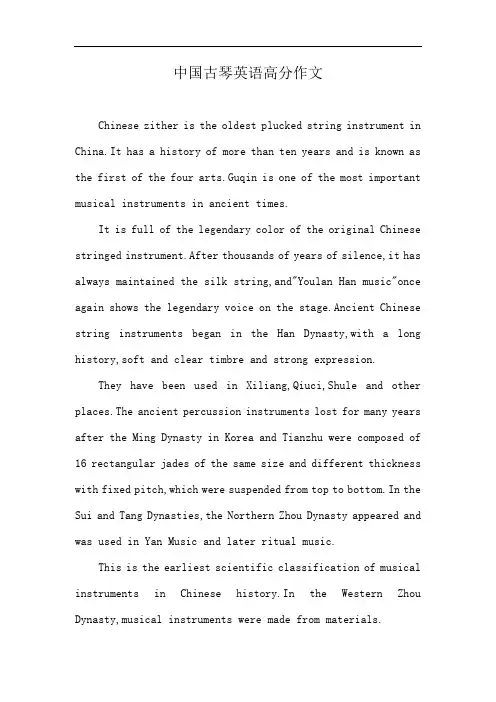
中国古琴英语高分作文Chinese zither is the oldest plucked string instrument in China.It has a history of more than ten years and is known as the first of the four arts.Guqin is one of the most important musical instruments in ancient times.It is full of the legendary color of the original Chinese stringed instrument.After thousands of years of silence,it has always maintained the silk string,and"Youlan Han music"once again shows the legendary voice on the stage.Ancient Chinese string instruments began in the Han Dynasty,with a long history,soft and clear timbre and strong expression.They have been used in Xiliang,Qiuci,Shule and other places.The ancient percussion instruments lost for many years after the Ming Dynasty in Korea and Tianzhu were composed of 16 rectangular jades of the same size and different thickness with fixed pitch,which were suspended from top to bottom.In the Sui and Tang Dynasties,the Northern Zhou Dynasty appeared and was used in Yan Music and later ritual music.This is the earliest scientific classification of musical instruments in Chinese history.In the Western Zhou Dynasty,musical instruments were made from materials.中文翻译:中国古筝是中国最古老的弹拨乐器,有着十多年的历史,被誉为四艺之首,古琴在古代是乐器中地位最高的一种,古琴充满了中国原始丝弦乐器的传奇色彩,它在沉寂了几千年之后,一直保持着丝弦,“幽兰汉乐”又一次展现了舞台上的传奇声音。
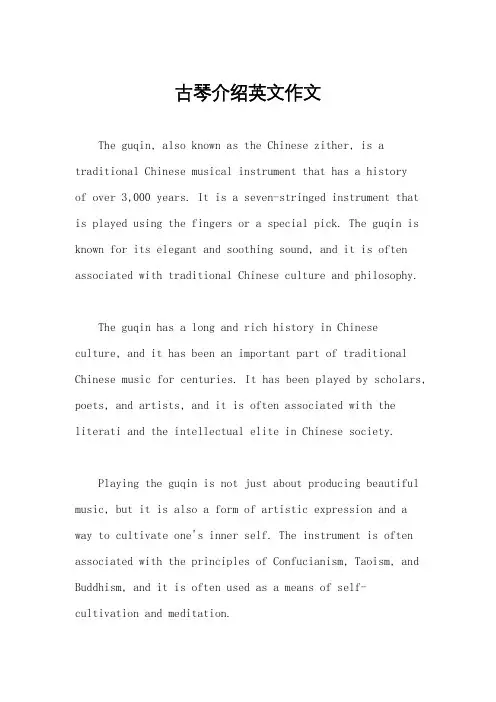
古琴介绍英文作文The guqin, also known as the Chinese zither, is a traditional Chinese musical instrument that has a historyof over 3,000 years. It is a seven-stringed instrument that is played using the fingers or a special pick. The guqin is known for its elegant and soothing sound, and it is often associated with traditional Chinese culture and philosophy.The guqin has a long and rich history in Chinese culture, and it has been an important part of traditional Chinese music for centuries. It has been played by scholars, poets, and artists, and it is often associated with the literati and the intellectual elite in Chinese society.Playing the guqin is not just about producing beautiful music, but it is also a form of artistic expression and a way to cultivate one's inner self. The instrument is often associated with the principles of Confucianism, Taoism, and Buddhism, and it is often used as a means of self-cultivation and meditation.The guqin has a unique and distinctive sound that is unlike any other instrument. Its music is often described as ethereal, mystical, and deeply spiritual. The instrument has a wide range of expressive capabilities, and it can produce a wide variety of sounds and tones, from soft and delicate to powerful and resonant.The guqin has had a profound influence on Chinese music and culture, and it continues to be an important part of traditional Chinese music today. It has also gained popularity in other parts of the world, and it is often regarded as a symbol of Chinese culture and heritage.。

古典乐器-中英文对照简介(范文)第一篇:古典乐器-中英文对照简介(范文)古琴:Qin, also known as Yao Qin, Yu-Qin, a lyre, for the Chinese one of the oldest plucked instruments, the qin is already prevalent in the Confucian period instruments, there are words to consider the history of thousand years, according to “Historical Records” contains, The emergence of Qin period no later than Yao and Shun.The beginning of this century, only for the distinction of Western instrument s in the “piano” added in front of a word “historic”, called “Qin.” Still ringing in his study so far, the ancient musical instruments on stage.巴乌Bau, is a bamboo reed instruments copper, spring for the tongue.The Yi, Hani, Dai, Wa, Blang, Miao and other ethnic wind instruments.Yi called the local “and Fei Limo”, Hani called “Meiba.” Bau is popular in southwest China Yi, Miao, Hani and other single-reed wind instrument family, Bau is made with bamboo, has eight finger holes(seven before the latter), disposed in the mouthpiece of a brass reed tongue tip, blowing across the top of playing, vibrating reed sound.Bau smaller volume, but the sound soft, southwest China's people call it a talking instrument.Bau popular in the Red River in Yunnan Province, Wenshan, Simao, Xishuangbanna, Lincang, Dehong, meltwater Guangxi Zhuang Autonomous Region, Guizhou Province, Guizhou and South Guizhou and other places.Dizi(笛子): The dizi is a bamboo flute.It has been suggested thatthe instrument originated in Southern orCentral Asia over 2000 yearsago.It is a unique solo instrument and isalso used extensively inensembles and orchestras.These flutes have 6open holes and a lovelybright sound.笛子是由竹子做成的乐器,据说在2000年前最早出现于南亚和中亚。
古琴介绍英文作文The guqin, also known as the Chinese zither, is a traditional Chinese musical instrument that has a history of over 3,000 years. It has a long, narrow wooden body, and its seven strings are strung over movable bridges. The guqin is known for its elegant and soothing sound, and itis often associated with scholarly and artistic pursuits in Chinese culture.Playing the guqin requires a high level of skill and precision. The player plucks the strings with their right hand and uses their left hand to press the strings at various points to change the pitch. The instrument has a wide range of expressive techniques, including bending, vibrato, and harmonics, which allow the player to create a rich and nuanced sound.The guqin has a deep cultural significance in China and is often associated with philosophical and spiritual pursuits. It has been used in traditional Chinese medicineto promote relaxation and healing, and it is also considered a symbol of Chinese cultural identity.In traditional Chinese music, the guqin is often used to accompany poetry, painting, and calligraphy. Its tranquil and meditative sound is believed to create a harmonious atmosphere and inspire creativity.The guqin has a unique place in the world of musical instruments, with its ancient history, rich cultural significance, and distinctive sound. It continues to be cherished and preserved as an important part of China's cultural heritage.。
Today, I am honored to stand before you to introduce one of the most ancient and noble musical instruments in China, the Guqin, also known as the "seven-stringed zither." As a symbol of Chinese civilization and cultural heritage, the Guqin has a history of over 3,000 years and has been deeply rooted in the hearts of the Chinese people.The Guqin is a plucked string instrument with a wooden resonator, seven strings, and movable bridges. It is played horizontally, with the musician sitting on the floor or a low chair. The Guqin is known for its elegant and melodic sound, which has been captivating listeners for centuries.The origin of the Guqin is shrouded in mystery, but it is believed to have been created by the legendary ancient Chinese musician, Yu. According to traditional Chinese mythology, Yu was the great flood hero who saved the world from disaster. After the flood, Yu created the Guqin to express his gratitude and happiness for his success.Throughout history, the Guqin has been highly regarded by scholars, artists, and literati. It was considered a symbol of refined taste and elegance, and was often associated with the pursuit of spiritual and intellectual growth. Many famous Chinese philosophers, poets, andartists have composed music or poems for the Guqin, and it has been featured in countless classical Chinese paintings and calligraphy.The Guqin's playing technique is highly sophisticated and requires years of practice to master. The musician must have a deep understanding of music theory, as well as the ability to express emotions and stories through the instrument's sound. The Guqin's tone is soft and delicate, yet it can also convey strong emotions and powerful narratives.There are many different types of Guqin music, including folk, classical, and contemporary. Folk Guqin music is often played in rural areas and reflects the local culture and customs. Classical Guqin music, on the other hand, is characterized by its complex melodies and intricate rhythms, and is often associated with Chinese literature and poetry. Contemporary Guqin music blends traditional techniques with modern elements, creating a unique sound that appeals to a wide audience.In recent years, the Guqin has gained increasing popularity around the world. More and more people are discovering the beauty and depth of this ancient instrument, and it is being featured in concerts, workshops, and educational programs. The Guqin's unique sound and cultural significance have made it a cherished part of the global musical landscape.In conclusion, the Guqin is not just a musical instrument; it is a representation of Chinese civilization and cultural heritage. Its elegant sound, rich history, and profound cultural significance have made it a beloved instrument among the Chinese people, and it continues to inspire musicians and listeners around the world. Thank you for your attention, and I hope that this introduction has helped you appreciate the beauty and magic of the Guqin.。
The Guqin
古琴
Guqin, It is a plucked seven-string Chinese musical instrument of the zither family with a history of more than 3000 years. The prefix "gu-" (meaning "ancient") was later added for clarification. It can also be called qixianqin (lit. "seven-stringed instrument").
古琴,又称中国七弦琴,为中国最古老的弹拨乐器之一, 有文字可考的历史有四千余年。
Guqin has traditionally been favored by scholars and literati as an instrument of great subtlety and refinement. Guqin has always been viewed as the first place among the four Chinese high culture activities such as Guqin, Chess, calligraphy and painting.
在中国古代,“琴、棋、书、画”历来被视为文人雅士修身养性的必由之径。
古琴因其清、和、淡、雅的音乐品格寄寓了文人风凌傲骨、超凡脱俗的处世心态,而在音乐、棋术、书法、绘画中居于首位。
.
Symbolism in the Guqin
古琴结构与文化象征
There are a lot of symbols around this instrument. 在古琴中我们可以找到许多中国传统文化的元素。
Guqin’s measurement line is 3 feet 65 inches representing the 365 days in a year. The top part is round representing the sky. The bottom part is flat, representing the earth. The whole body of the Guqin correspond the body of phoenix which is a bird of wonder, also the body of Guqin looks like the human body, with head, neck, shoulder, waist and feet etc.
琴一般长约三尺六寸五(约120—125公分),象征一年三百六十五天(一说象周天365度)。
一般宽约六寸(20公分左右)。
一般厚约二寸(6公分左右)。
琴体下部扁平,上部呈弧形凸起,分别象征天地。
整体形状依凤身形而制成,其全身与凤身相应(也可说与人身相应),有头、颈、肩、腰、尾、足。
There are 13 stars/markers representing the 13 month of Chinese lunar year. The stars/markers are filled in the Guqin with shells or gold, silver, jade, pearl make point, called the "Hui” (emblem) to indicate the sound position. The biggest Hui (star/marker) representing the lunar month.
自魏晋时古琴的表面便设置了十三个琴徽. 即琴弦外侧镶嵌了十三个用贝壳或者金、银、玉石、珍珠做成点,称作“徽”,表明泛音位置,提示按弦。
十三徽分别象征十二月,而居中最大之徽代表君象征闰月。
There are 7 strings in of Guqin. The first 5 in pentatonic scale representing 5 elements Metal, wood, water, fire and the earth. The 6 string was added by King Wen when his son was died. So the 6 string is sorrowful. The 7 string was added by King Wu when he encourage his soldiers go to the war. So the 7 string is very strong.
古琴最初只有五根弦,内合五行,金、木、水、火、土;外合五音,宫、商、角、徵、羽。
后来文王囚于羑里,思念其子伯邑考,加弦一根,是为文弦;武王伐纣,加弦一根,是为武弦。
合称文武七弦琴。
The Guqin produce the most diligent and subtle tones. There are 3 category sounds produced by the Guqin. Harmonics is representing the sound from the Heaven. Open Strings is representing the sound from the earth. Stopped string is representing the Human Beings.
古琴有泛音、散音和按音三种音色,泛音法天,散音法地,按音法人,分别象征天、地、人之和合。
安妮总结于壬辰夏
Summarized by Annie Li July 2012 in Tianjin。